Competing to Win Tour Visits Merck KGaA in Darmstadt, Germany, and VDMA in Frankfurt
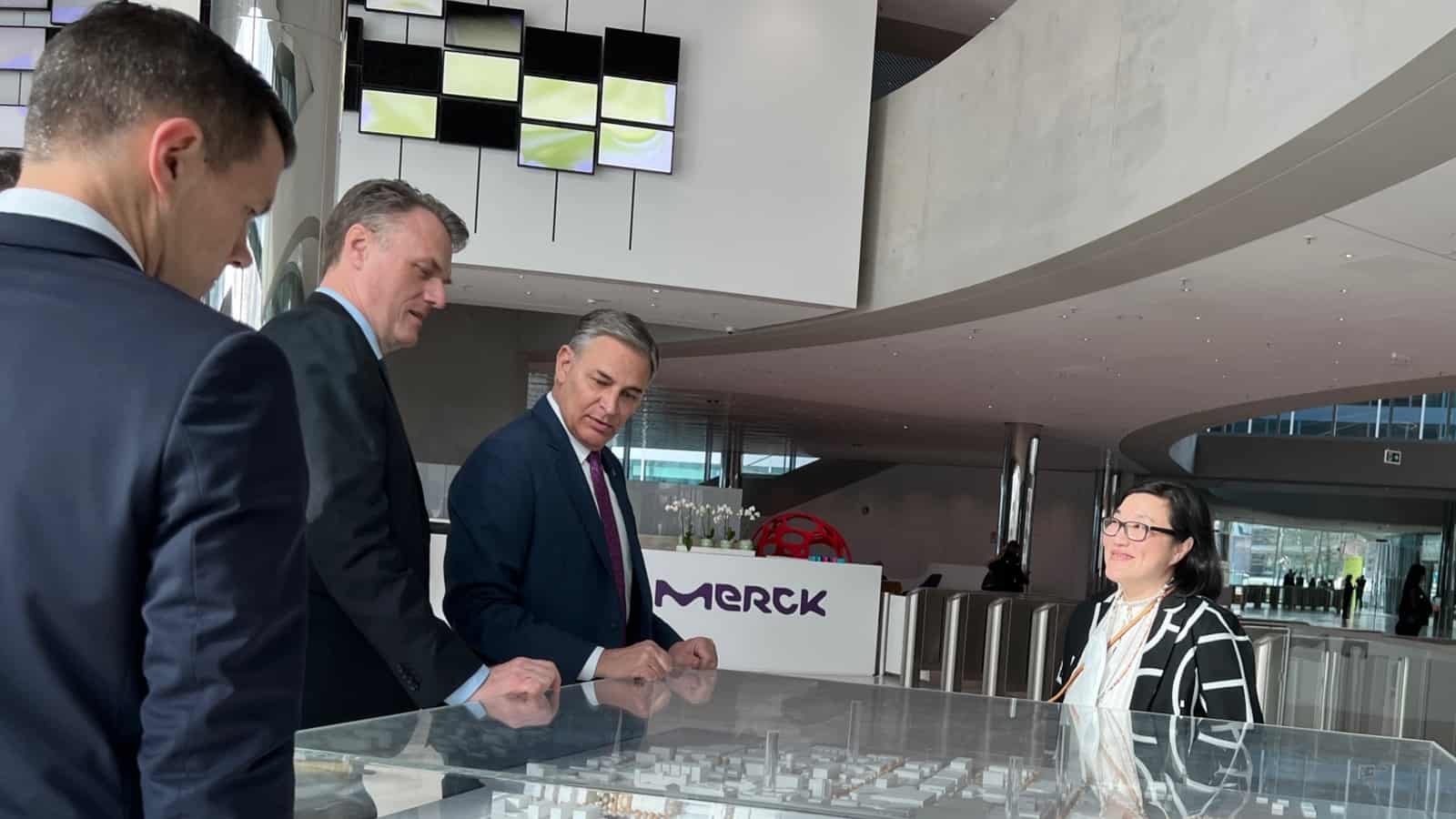
The NAM’s Competing to Win Tour in Europe continued with stops at Merck KGaA in Darmstadt and VDMA, the association of Germany’s engineering industry, in Frankfurt. The visit to Merck KGaA provided a firsthand look at the leadership, culture and operations that are producing about 300,000 products and that played an instrumental role in saving the world from the pandemic.
Living its values: Merck KGaA and its science and technology entities have 60,000 employees around the globe, with approximately 26,000 employees in 66 countries outside of Germany, including the U.S. Its products appear not only in healthcare settings, but in grocery stores where they ensure food and beverages are safe and in transportation where they monitor the air we breathe.
- Matthias Heinzel, CEO of the Merck KGaA Life Science business, and Thaddeus Burns, head of government and public affairs, welcomed the tour and provided insights into the company’s operations.
- The tour of the Merck Innovation Center showcased the company’s state-of-the-art design and technology, while the visit to the growing Membrane operations gave the tour group an opportunity to explore the latest developments.
- A brief stop in the company’s museum provided a historical perspective on the origins of the company, which was founded by the Merck family and began with a small pharmacy named Angel that is still in business today.
VDMA: The tour group also visited VDMA, the association of Germany’s engineering industry, which represents more than 3,300 companies in the sector and focuses on the advancement of trade opportunities.
The last word: The visit to Merck KGaA in Darmstadt underscored the importance of interconnectedness between the U.S. and Europe. It highlighted the vital role alliances play in strengthening enterprises that are essential to our democratic way of life and its protection worldwide.
- “Merck KGaA is a company that lives its values and is a strong champion of free enterprise, competitiveness, individual liberty and equal opportunity, putting its aspirations into action,” said NAM President and CEO Jay Timmons.
The NAM Tours World’s Largest Chemical Complex
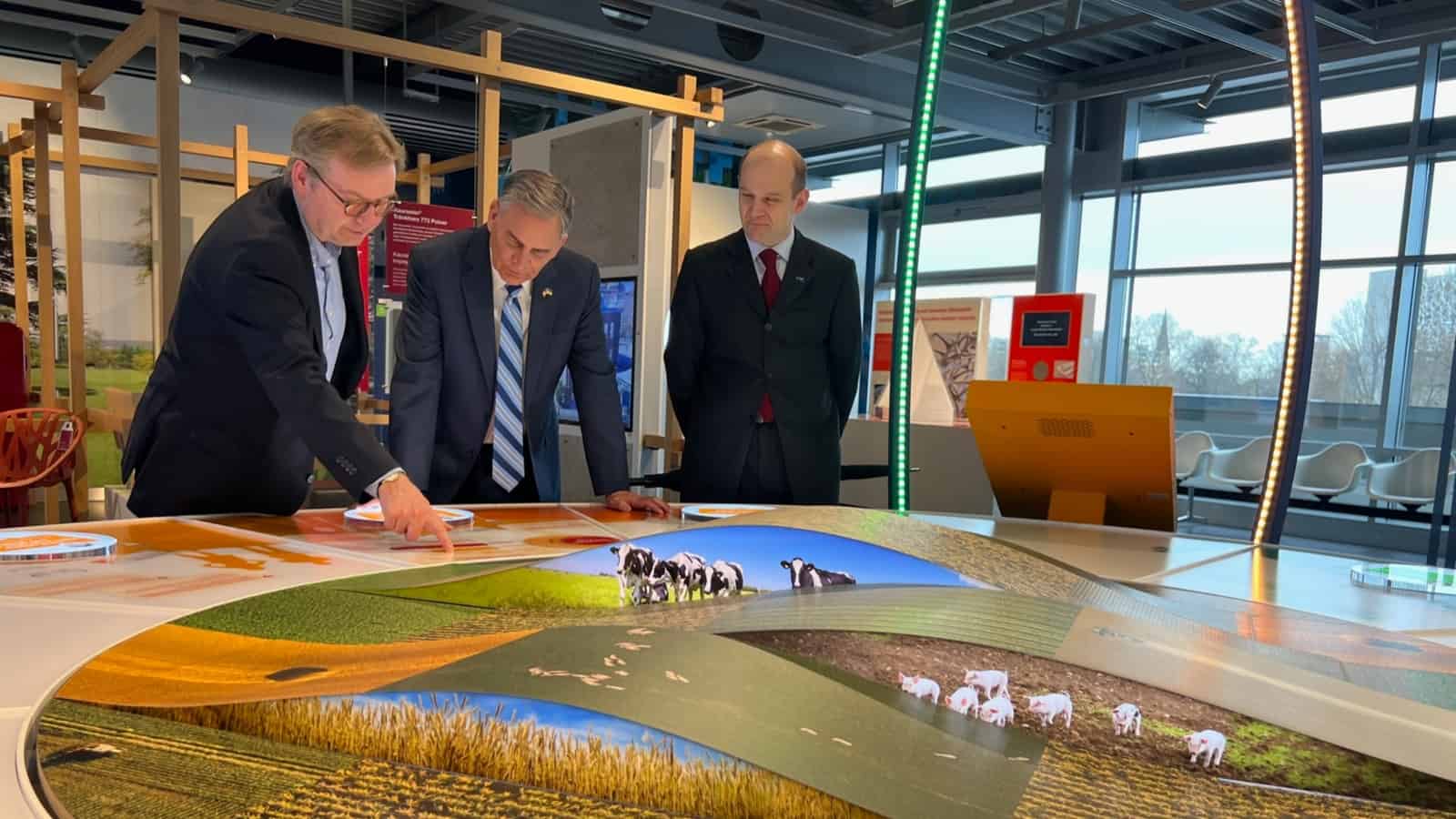
As part of the Competing to Win Tour in Europe, NAM President and CEO Jay Timmons visited the world’s largest integrated chemical complex and the headquarters of BASF in Ludwigshafen, Germany, this week. The visit highlighted how BASF is addressing global challenges and providing a powerful example of manufacturers’ leadership.
BASF in North America: BASF employs more than 16,000 workers in North America. Its facilities include large, integrated, production-energy flow-logistics operations in Geismar, Louisiana, and Freeport, Texas.
- Led by BASF North America President and NAM board member Tobias Dratt, the company has been a strong supporter of the initiatives of the Manufacturing Institute, the NAM’s 501(c)3 workforce development and education affiliate, to build the workforce of the future.
- This includes the Creators Wanted campaign, which aims to inspire the next generation of manufacturers and help companies source talent.
- BASF was among the first companies to advance the NAM and MI’s “This Is Our Shot” Project to increase awareness about COVID-19 vaccinations.
The visit: Timmons met with company leaders forging a path to the future.
- These included BASF Global Business Services President Marc Ehrhardt and Chief Technology Officer and Board of Executive Directors member Dr. Melanie Maas-Brunner.
- Timmons also had the opportunity to take part in a BASF immersive experience, one of the company’s innovative approaches to building community awareness about its impact and the promise of the chemistry industry.
The last word: “To fortify the global economy and strengthen the values of free enterprise, competitiveness, individual liberty and equal opportunity—as well as the capacity for democracy to raise standards of living here at home and around the globe—it’s going to take action in the U.S. and Europe,” Timmons said after the visit.
- “Policymakers must continue boosting supply chain resiliency, energy security and regulatory certainty. The decisions that leaders on both sides of the Atlantic make will determine whether companies like BASF can continue to grow, invest and innovate for a better life for all.”
AB InBev Uses Smart Manufacturing for Award-Winning Results
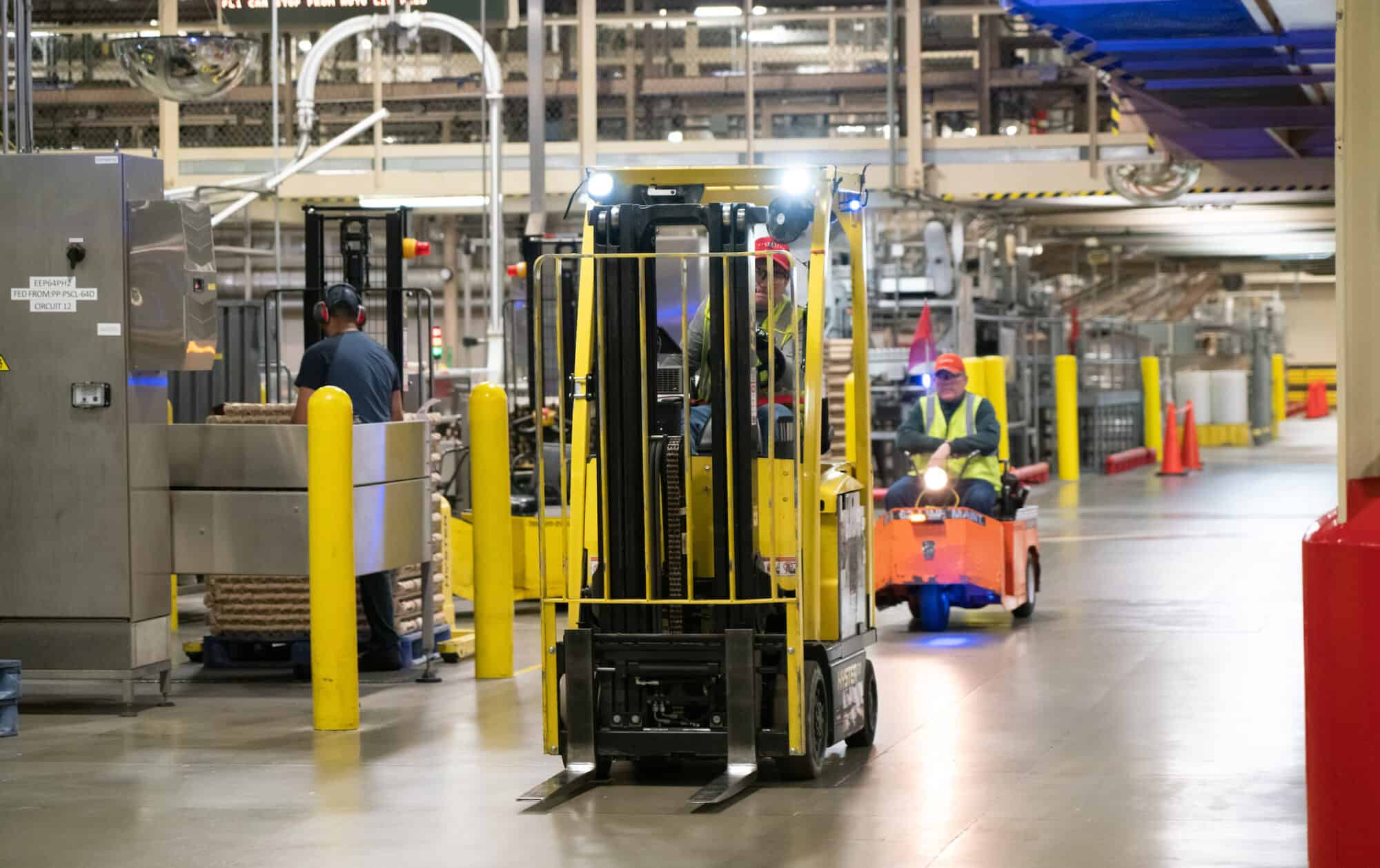
What does it take to be a digital transformation champion? Anheuser-Busch InBev can tell you.
The world’s largest brewer won four Manufacturing Leadership Awards in 2022, including the highly coveted Manufacturer of the Year. (The honors are given annually by the Manufacturing Leadership Council, the NAM’s digital transformation arm.) The MLC chatted with AB InBev Global Vice President Marcelo Ribeiro recently to get his insights on the processes, technologies and strategies driving the company’s success.
Business transformation drivers: “We have a dream at ABI, which is ‘to create a future with more cheers,’” said Ribeiro. “[That means] a clear strategy to lead and grow, to digitize and monetize our ecosystem and to optimize our business.” Here are a few ways AB InBev is pursuing that dream:
- Developing and delivering products that give consumers what they want, when they want it
- Making sure the supply chain can adapt quickly to consumer needs
- Increasing capacity without compromising safety, quality or sustainability
Rising to challenges: “The future is becoming less predictable,” Ribeiro said. “We need to prepare for that, so we have to build a more resilient, flexible supply chain.” Additional opportunities include:
- Moving from transactional relationships with vendors and suppliers to partnerships
- Looking beyond operations and across the entire supply chain to meet sustainability goals
- Creating a collaborative manufacturing ecosystem that fosters the sharing of ideas
Meeting the digital future: Ribeiro says that ABI’s digital strategy has three key aspects:
- Making data more accessible and available to frontline workers
- Creating a template for digital technology that can be easily tailored to the unique needs of each business
- Using advanced analytics to contextualize data and discover where it can best be applied to aid decision making
Leaders required: Ribeiro noted that leadership is essential for making this vision a reality.
- “It is critical to empower the front line,” he said. “Leaders should be focused on providing the resources to allow people to do the work and achieve excellence themselves. In the end, people are key for any business transformation.”
Find additional insights into AB InBev’s digital transformation in DIALOGUE: AB InBev’s Award-Winning Dream, or make plans to attend Rethink, where Ribeiro will present a keynote address on “Building Your Enterprise into a Digital Transformation Champion.”
E-Cycling Helps Manufacturers Generate Business Value

Electronic waste is a big problem.
In 2019, the world generated a record 53.6 million metric tons of discarded electronic and electrical devices, according to a Global E-waste Monitor report. That’s an increase of 21% in just five years. But there’s more: The figure is expected to double by 2050, hitting 120 million tons annually.
The good news is that manufacturers can be an active part of the solution. Though their bread and butter has typically been bringing new products to market, manufacturers are now also developing end-of-life processes for goods to mitigate environmental impact, according to Bright Machines Vice President of Industrial Solutions Adam Montoya, writing in the Manufacturing Leadership Council’s Manufacturing Leadership Journal. (The MLC is the digital transformation division of the NAM).
The challenge: complex components. Disassembling a product is not nearly as straightforward as assembling it, according to Montoya. Take a server, for example. A company might know what’s inside it based on its original configuration, but memory or processor upgrades could have changed over the course of its life.
- When a lot of change has taken place, the dismantling process is unique to each server, making it complex and difficult to automate.
The solution: intelligent disassembly. Improving the end-of-life process for electronics requires intelligent disassembly, a combination of smart technology and a different way of thinking, says Montoya. Here’s how it works:
- Automation technology that uses AI and advanced vision systems interprets the contents of a particular component and compares it against the original blueprint.
- Next, the system assesses the presence and location of components within the unit.
- It then sorts, separates and removes components so they can be reclaimed or recycled.
The bottom line: Manufacturers stand to realize many benefits from intelligent disassembly. Components with sensitive data can have machine-driven proof of destruction. Systems with usable parts can be repurposed rapidly.
- Ultimately, it’s an important way for manufacturers to collectively reduce carbon footprints and electronic waste while delivering business value, says Montoya.
For more on this topic, read Rethinking End-of-Life Technology Value in the Manufacturing Leadership Journal. And to learn more about how manufacturing leaders are undertaking digital transformations, join the MLC at its Rethink conference in Marco Island, Florida, on June 26–28.
Manufacturers Lend a Hand in Turkey, Syria
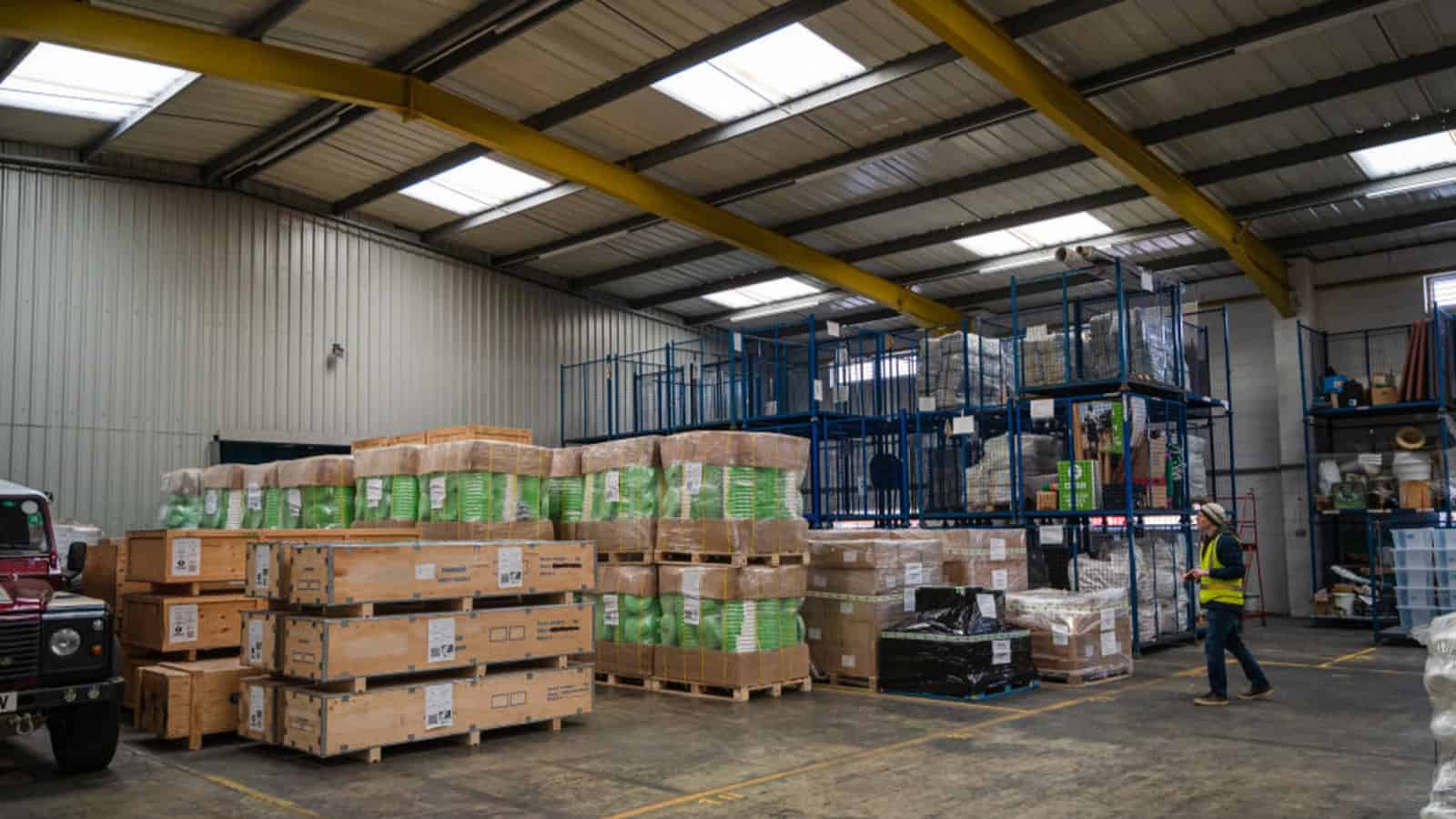
It’s been nearly a month since a devastating earthquake hit Turkey and Syria, killing at least 50,000 people—but manufacturers haven’t stopped lending a hand.
What’s going on: Through NAM Emergency Response Committee partners Project HOPE and Good 360, as well as other avenues, manufacturers in the U.S. were among the first to offer supplies and services to survivors. Here is just a sampling of the aid they provided.
Transport help: Manufacturers in the logistics sector stepped up to help ship necessary goods and supplies.
- The UPS Foundation has committed $1 million in global logistics support and employee-contributions matches.
- FedEx has committed more than $1 million of in-kind shipping so far.
Funds: Others are giving sizable monetary donations to the relief efforts.
- The Caterpillar Foundation is donating $400,000 to support relief efforts.
- Boeing Charitable Trust is giving a $500,000 donation.
- Novartis is donating $1 million.
- Rockwell Automation is donating $50,000 to the American Red Cross.
- Siemens has donated more than $1 million.
Supplies: Many manufacturers have also been donating much-needed goods to the earthquake victims.
- In addition to donating $1.2 million, the PepsiCo Foundation has partnered with nonprofits Tider and Ahbap to deliver essentials, including food, water, sanitation and hygiene products, along with container shelters, blankets and other emergency supplies.
- The Kraft Heinz Foundation is sending food and care products and donating $500,000 to the Red Cross.
- The Abbott Fund has committed $1.5 million in grants and product donations.
How to help: If you’d like to help those in need in Turkey and Syria, the NAM Emergency Response Committee offers options:
- To donate needed products—including hygiene kits, cold-weather clothing or health supplies—please visit Good360’s goods-donation page.
- If you want to give funds to support humanitarian relief, you can do so via the NAM’s partnership with Project HOPE.
Share your story: The NAM Emergency Response Committee is looking to hear from manufacturers about how they may have been affected by the earthquake and how they may be helping. To share your stories, please contact the NAM Emergency Response Committee at [email protected].
Modine Keeps the Digital Economy Cool and Functional
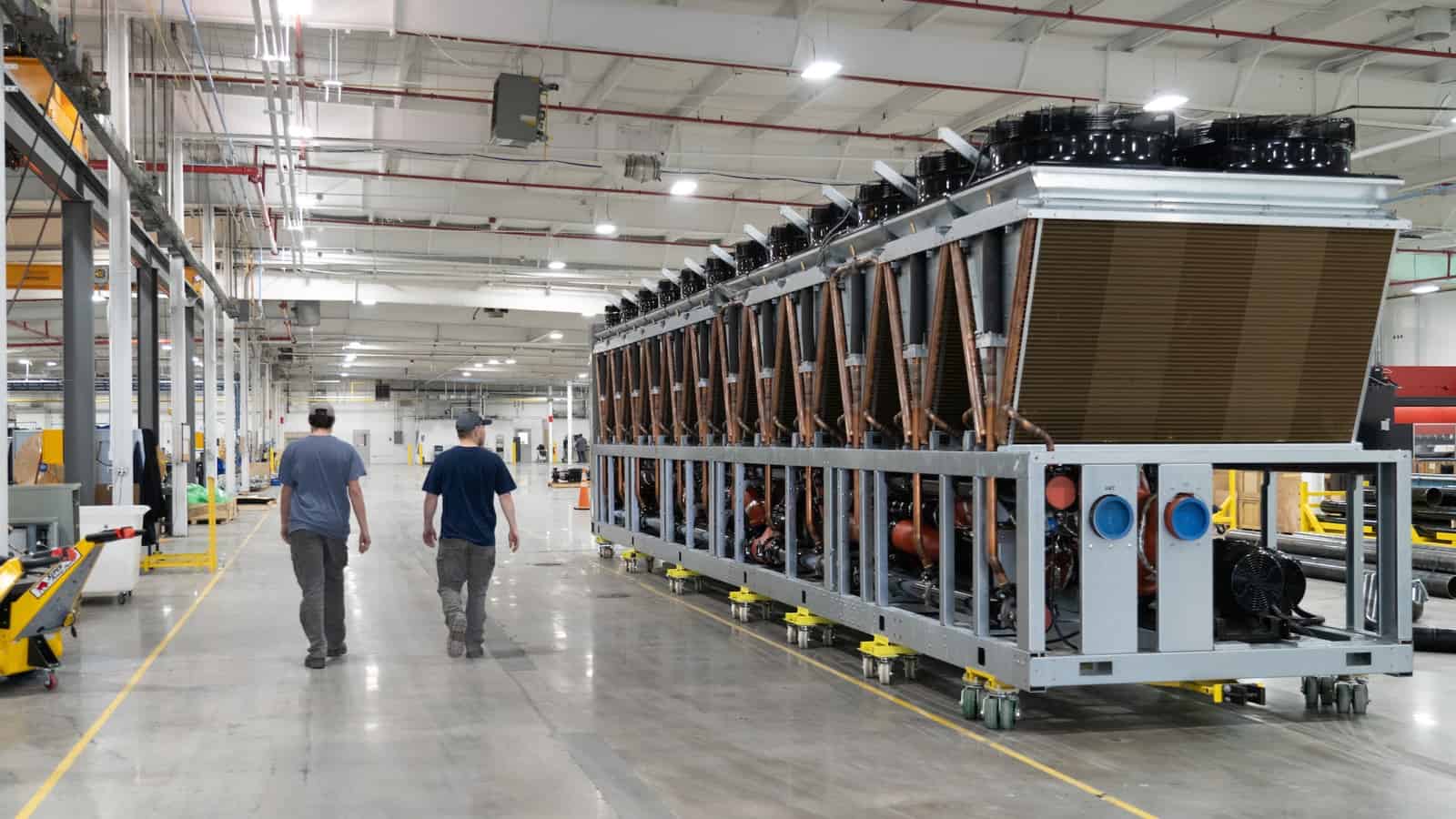
Here’s the secret ingredient in the digital economy: data center chillers. All those enormous data centers that keep track of your bank account, work emails and lunch orders get very hot, requiring state-of-the-art cooling technology to keep them functional and efficient.
We recently got to see how these enormous machines are made, courtesy of Modine Manufacturing, which opened its first data center chiller production plant in Rockbridge, Virginia, back in November. NAM Senior Director of Photography David Bohrer captured the production line in action, while several of Modine’s leaders spoke to the NAM at a later date about the technology involved.
Why chillers? The demand for data center chillers rises with the demand for data, which seems to be pretty much endless nowadays.
- As Darren Farrar, Modine’s global head of marketing for data centers, explained, “Data centers are always on; they are constantly processing data and therefore producing heat. They use a lot of energy, so any incremental improvements we can make [in cooling technology] can make a lot of difference to energy bills.”
- That’s where Modine comes in. Though chillers have been around since the 1920s, the needs of the digital economy mean that further innovation and specialization are always necessary.
How it works: A chiller provides cool water to the data center building while removing the heat that is returned from it, in an endless cycle.
- Modine’s chillers have two circuits, one of which uses outdoor air to chill the water, in a process called “free cooling,” explained Rob Bedard, general manager of data centers, North America. It’s a method that provides considerable energy savings.
- The chiller also has a “classical” refrigeration circuit for when outdoor temperatures aren’t helpful. Last, fans on top of the unit vent heat away from the building.
How it’s made: The Rockbridge plant is Modine’s first data center chiller plant in the U.S. and is situated in Virginia due to the state’s high concentration of data centers, said Bedard. The facility is “purpose-designed” for production, and everything is done on site:
- Technicians cut the parts from raw materials, then add refrigeration, suction and the distinctive V-shaped pipes for coolant, explained Tommy Johnson, Rockbridge’s plant manager.
- The assembly line checks the pressure, ensures there are no leaks and does final testing, he added. The facility even hosts demonstrations for customers in a state-of-the-art test lab, so they know what they’re getting.
Here a team constructs the metal frame of the chiller and adds insulation to the copper pipework and heat exchangers that carry the refrigerant:

Another technician installs the massive fans on top of the structure, which draw air through the huge V-shaped heat exchangers, removing the heat and venting it upward:
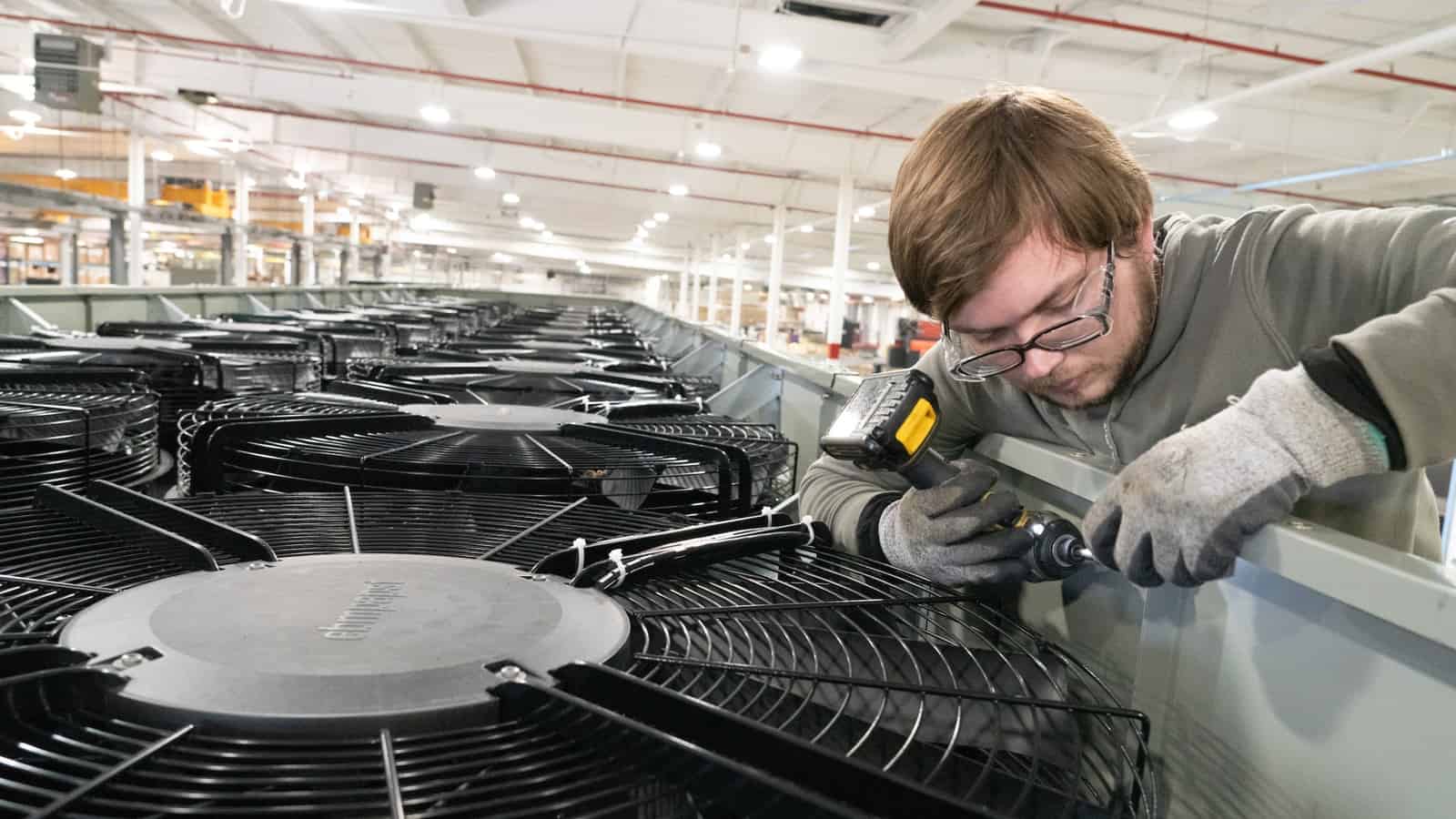
These copper pipes circulate water through the unit:
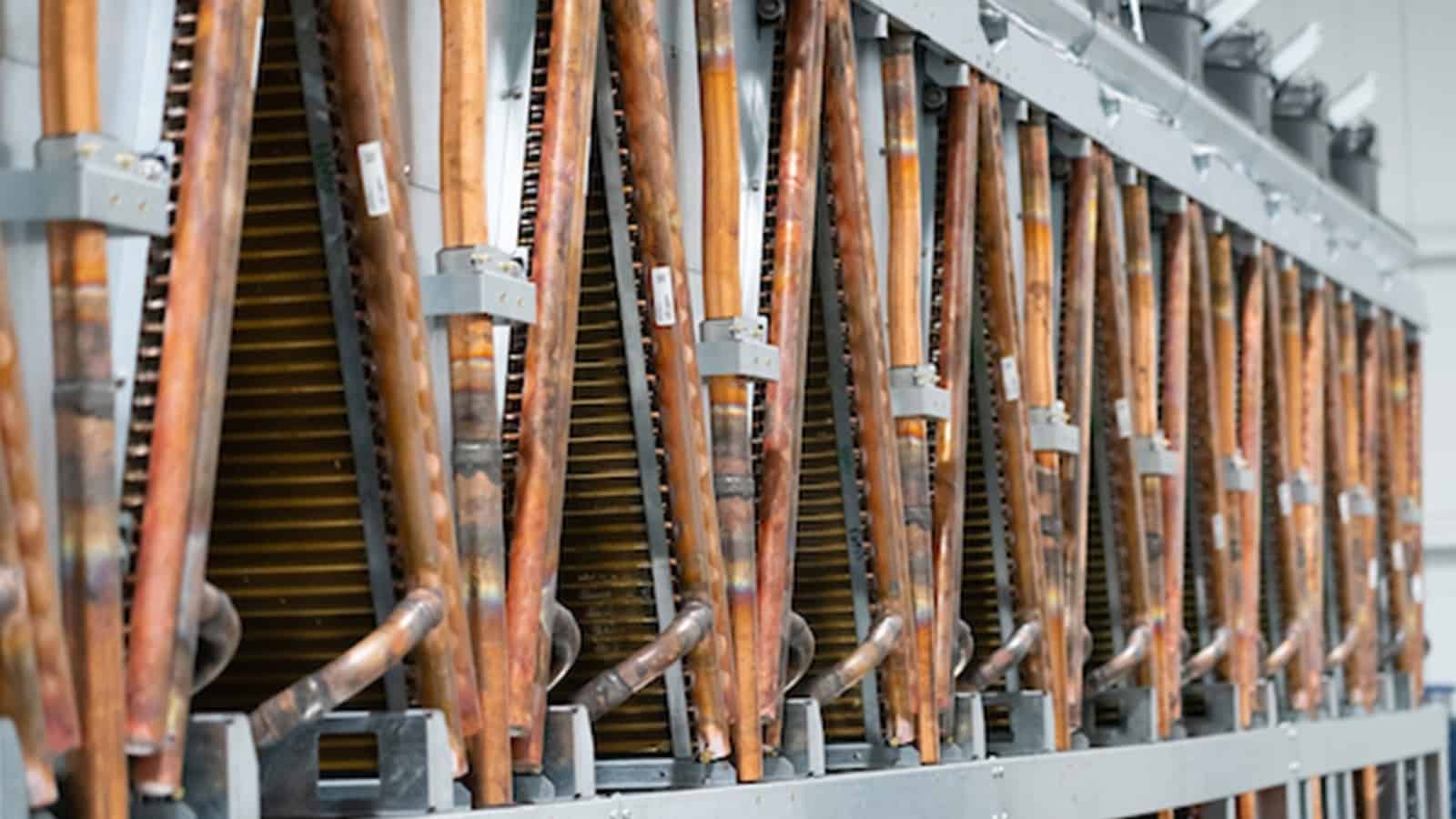
And last, here is the nearly finished chiller, which stands an impressive 10.1 feet tall, 45.6 feet long and 7.8 feet wide:
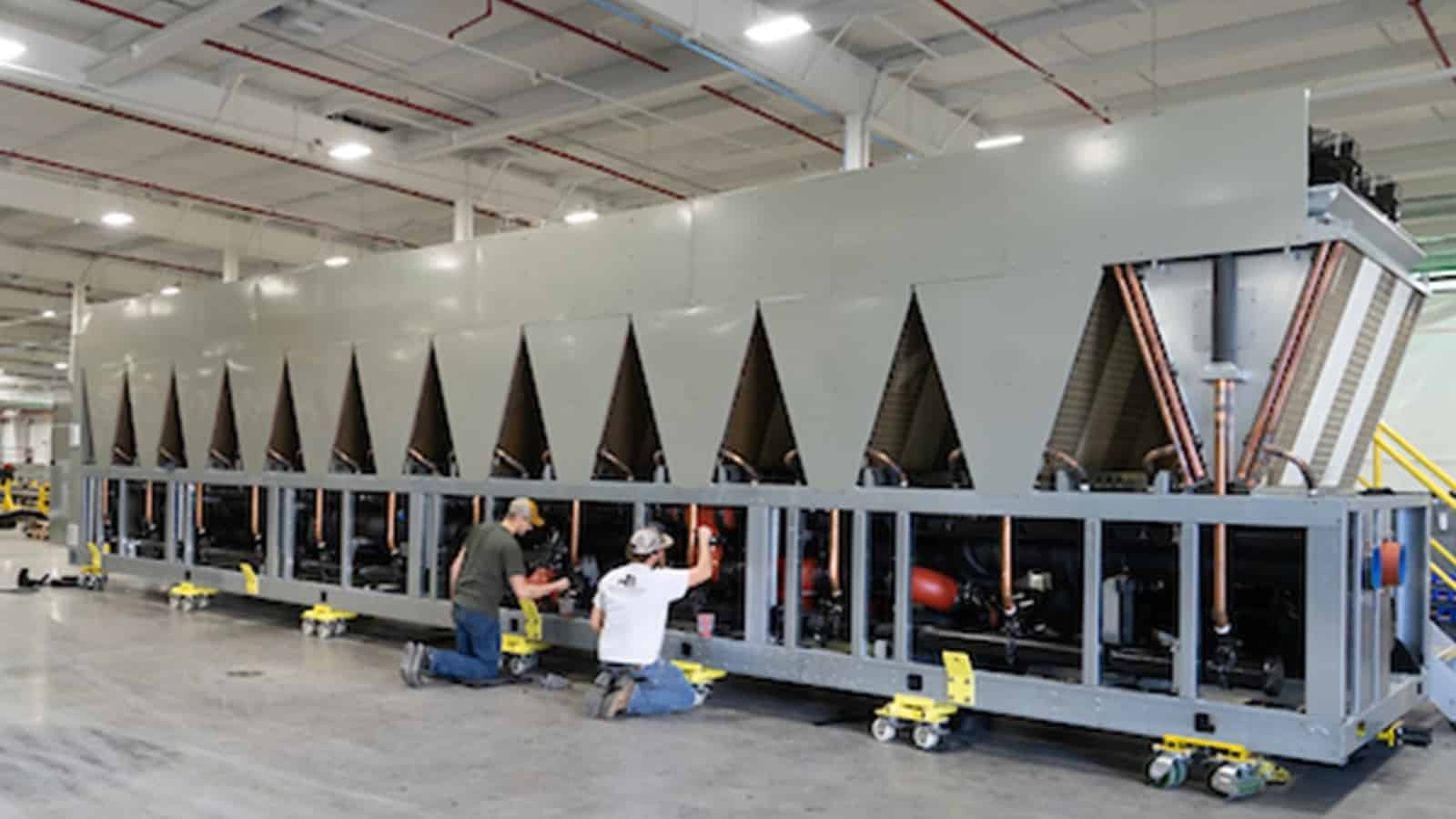
What’s next: What does Modine predict for the future of this market?
- “As big IT companies develop high-density chips,” Farrar said, “existing data centers will only become more powerful—and thus hotter.” Meanwhile, the increasing use of AI and cryptocurrency will also lead to greater demand for data centers.
- In addition, sustainability will only become more of a priority. As Farrar put it, the data chiller industry will have to learn to grow sustainably throughout its supply chain—by using fewer and greener refrigerants, reducing water and carbon usage and more.
- Modine plans to meet these challenges with its newly commissioned testing center at the Rockbridge facility, where it will do all its own testing and validation for the North American market, Farrar said.
Off to a great start: Today, Modine is confident and optimistic, having recently delivered Rockbridge’s first batch of chillers to a Corescale data center in Gainesville Crossing, Virginia. It was “the culmination of all our efforts for a 2-year period,” said Farrar—a real “red letter day.”
“A Catalyst for Change”: Nucor Is All in on Sustainability
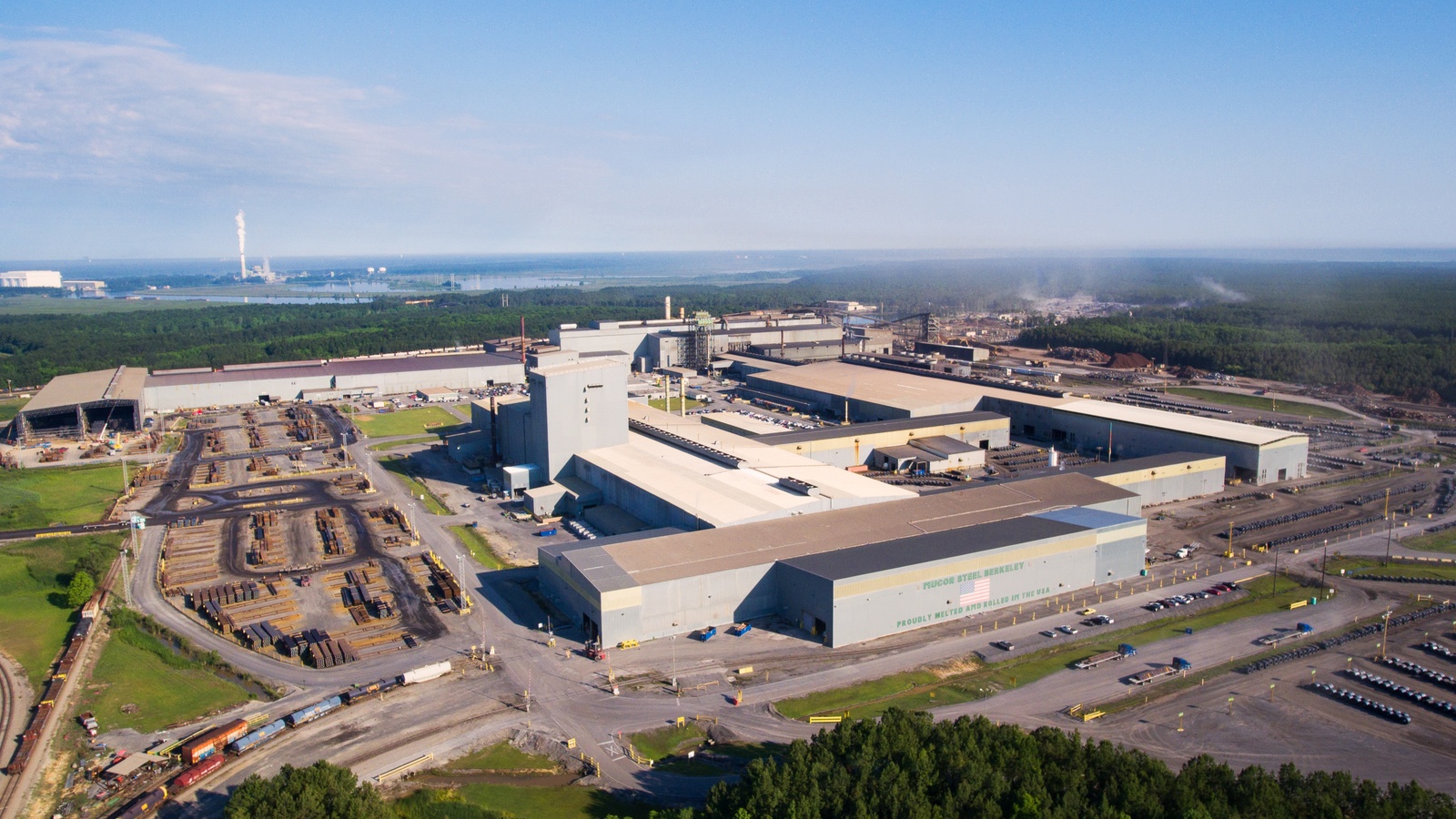
Nucor is one of the cleanest steel companies in the world. Recently, the producer of low embodied carbon steel and steel products committed to further reducing emissions and increasing its global sustainability efforts by joining the United Nations’ 24/7 Carbon-free Energy Compact.
But that’s just the latest in a long list of sustainability initiatives from the company.
Lofty goals: Nucor has committed to a 35% reduction of its steel-mill greenhouse-gas intensity by 2030—no easy feat in the sector, said Nucor Executive Vice President of Business Services and General Counsel Greg Murphy.
- “The levers that companies in this industry can pull depends on the geographic location you’re in, your access to materials and even the geology of the region in which you operate,” Murphy said. “We’re making steel out of recycled content and the fact that we start out with some of the lowest industry greenhouse-gas emissions levels on the planet gives us an advantage.”
- Much of this advantage comes from the company’s use of electric arc furnaces to recycle scrap metal into new steel products, a process Nucor pioneered in the U.S.
- However, EAFs consume large amounts of electricity, making cleaner energy sources an important part of the company’s efforts to reduce emissions. Approximately 40% of the electricity Nucor uses now comes from clean or renewable sources, according to Murphy.
Green upgrades: Nucor is looking at all corners of its operations for ways to reduce and improve.
- The company is building a new rebar “micromill” (its third in the past five years) to make rebar for infrastructure and construction projects. Micromills eliminate the need for reheat furnaces, further reducing Nucor’s use of natural gas.
- Nucor is also considering replacing charge and injection carbon—two solid-carbon sources used in its furnaces—“with recycled and wood components, which would significantly reduce emissions,” Murphy said.
- In addition, the steel manufacturer is investing in ways to extract nonferrous materials, such as copper, from obsolete scrap. More reuse means a smaller carbon footprint, according to Murphy.
- Finally, the company is exploring the use of carbon capture and sequestration at one of its facilities and is investing in alternative iron-making technologies that would enable it to produce carbon-free, high-quality iron.
Bringing in nuclear: Nucor takes an all-of-the-above approach to energy, which is what will allow it to fulfill the goals of the U.N. compact, according to Murphy.
- “A fundamental premise of [the compact] is that access to affordable, clean energy is essential to the world’s sustainable future,” Murphy said. “That’s one of the things that really attracted us to it—this emphasis on not just providing renewable energy, but providing affordable, reliable and clean energy. That’s not only solar and wind, but also geothermal, hydroelectric and, critically, nuclear. We think that all of these forms of clean energy have a role to play.”
- Last year, Nucor invested in NuScale Power, a company developing small modular nuclear reactors. The U.S. Nuclear Regulatory Commission recently approved the design and the first operational reactor is expected by the end of this decade.
The final word: “At the end of the day, the sustainability issue is not going to go away,” Murphy said. “It’s here to stay, and I think companies can either move in this direction kicking and dragging their feet, or they can do it with leadership. The developed world needs to lead the developing world. We need to be a catalyst for change.”
Zelenskyy to Manufacturers: We Will Prove That Democracy Is Stronger Than Tyranny
Timmons: America, and the American business community, stands with Ukraine today, tomorrow, through the end of the war
Boca Raton, FL – This morning, Ukrainian President Volodymyr Zelenskyy delivered remarks to the National Association of Manufacturers Board of Directors.
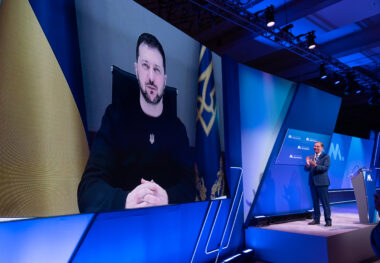
To view the address and a transcript of the remarks, click HERE.
Key Excerpts:
Voldodymyr Zelenskyy, President of Ukraine:
But what will our joint victory mean? This is not a purely ideological battle. Yes, we will prove that democracy is stronger than tyranny. When Russia loses, we will prove that terrorist states cannot overcome the power of a united democratic world.
…..
The American business [community] has every opportunity to take on leadership positions both in the reconstruction of the Ukrainian economy and infrastructure, and in demonstrating to the world that human nature should serve worthy goals and that it produces, and will always produce, the best result.
……
All these are not just investment opportunities, not just industries and not just growth. This is a wide space for victories—your victories, American business. And I urge you to prepare for these victories now, to come to Ukraine now so that by the time we restore peace, your hard work has already yielded results. And I believe that it will be soon. Thank you for your attention. I invite all of you to Ukraine. Glory to our brave soldiers. Glory to Ukraine.
Jay Timmons, President and CEO, National Association of Manufacturers:
Ukraine’s fight is our fight because this is far more than a war between two countries. It is a battle between freedom and tyranny. So America, and the American business community, stands with Ukraine today, tomorrow, through the end of the war and as Ukrainians rebuild their country after Russia is defeated.
….
We reaffirm our support for the “sanctions implemented against Russia” and for Ukraine’s “fight to preserve freedom and independence.” And we reaffirm our “commitment … to safeguarding democracy and democratic institutions not only here at home, but also abroad.”
…..
Manufacturers in America will continue to stand with Ukraine, and we will be there after Russia is defeated so that we can help you and your people build a stronger nation forever rooted in our shared democratic values.
BACKGROUND: The NAM has been an active and vocal supporter of Ukraine’s fight to defend democracy. More information on these efforts can be found below:
- NAM State of Manufacturing address, opening comments on Russia’s brutal invasion of Ukraine (Feb. 21, 2023)
- Timmons: Biden’s Visit Shows the World That the U.S. Stands with the Ukrainian People (Feb. 20, 2023)
- Manufacturers Support Aid for Eastern Europe (Jan. 26, 2023)
- Manufacturers in the U.S. Stand with Ukraine, Memorandum of Understanding between the NAM and the Ukrainian League of Industrialists and Entrepreneurs (Jan. 25 2023)
- Manufacturers Lead with Their Hearts in Ukraine Aid (March 23, 2022)
- Manufacturers United in Support of Ukrainian People, NAM Board of Directors’ unanimous resolution denouncing Russia’s aggression (March 8, 2022)
-NAM-
The National Association of Manufacturers is the largest manufacturing association in the United States, representing small and large manufacturers in every industrial sector and in all 50 states. Manufacturing employs nearly 13 million men and women, contributes $2.81 trillion to the U.S. economy annually and accounts for 55% of private-sector research and development. The NAM is the powerful voice of the manufacturing community and the leading advocate for a policy agenda that helps manufacturers compete in the global economy and create jobs across the United States. For more information about the NAM or to follow us on Twitter and Facebook, please visit www.nam.org.
NAM Honors Snap-on CEO Nick Pinchuk for Extraordinary Commitment to Manufacturing in America
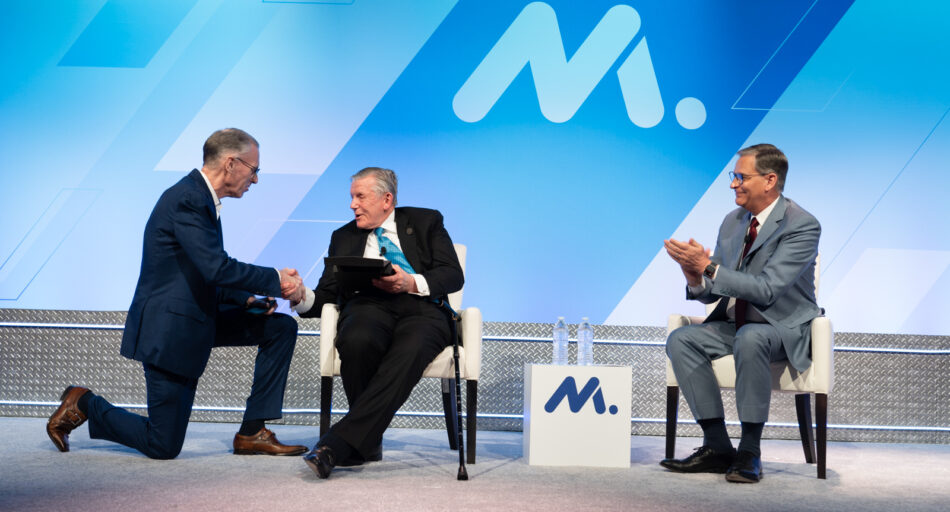
Boca Raton, FL—The National Association of Manufacturers today honored NAM board member and Snap-on Chairman and CEO Nick Pinchuk with the Manufacturing Icon Award during the NAM’s spring board meeting in Boca Raton, Florida. The award recognizes leaders who inspire Americans to promote, perpetuate and preserve manufacturing in America.
“Across the industry and across the business community, executives and employees alike look up to Nick Pinchuk. His storied career is a source of inspiration, and he is a wealth of knowledge, a wise counselor and a tireless advocate for the rewarding careers found in modern manufacturing. He has been a tremendous supporter of the NAM and the Manufacturing Institute’s Creators Wanted campaign to build the manufacturing workforce of today and tomorrow, and his policy advocacy on behalf of the industry is best-in-class,” said NAM President and CEO Jay Timmons.
“His presence on television and in the public eye as a principled manufacturing leader, as well as his unwavering service to the NAM and to our industry, makes Nick a true model for business leaders in America. In whatever he does, he demonstrates an unshakeable commitment to the values that have made our country exceptional and keep manufacturing strong: free enterprise, competitiveness, individual liberty and equal opportunity. We’re honored to present this award to Nick in recognition of his outstanding leadership.”
Pinchuk serves on the NAM Executive Committee as the NAM tax, domestic economic and regulatory reform policy vice chair and on the board of directors of the Manufacturing Institute, the workforce development and education partner of the NAM.
-NAM-
The National Association of Manufacturers is the largest manufacturing association in the United States, representing small and large manufacturers in every industrial sector and in all 50 states. Manufacturing employs more than 13 million men and women, contributes $2.81 trillion to the U.S. economy annually and accounts for 55% of private-sector research and development. The NAM is the powerful voice of the manufacturing community and the leading advocate for a policy agenda that helps manufacturers compete in the global economy and create jobs across the United States. For more information about the NAM or to follow us on Twitter and Facebook, please visit www.nam.org.
Pella Corp. Takes a “Holistic” Approach to Work
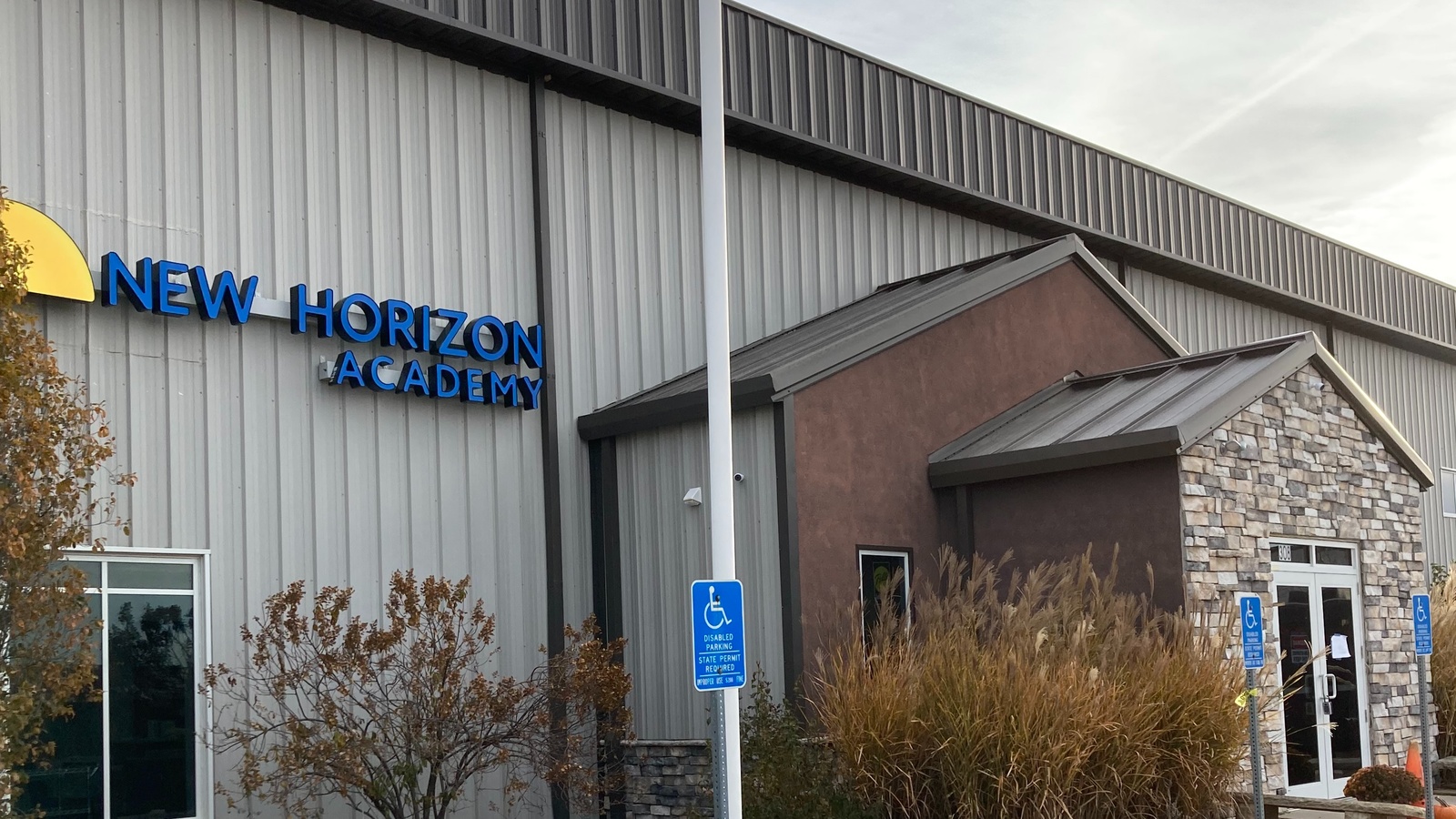
Pella Corp. does more than make windows and doors; it has helped create a welcoming, pleasant community in its namesake Iowa town.
To help attract and retain workers, the privately held, family-owned, 98-year-old company and its shareholders are investing in a number of crucial amenities and services, including child care, housing and dining/entertainment options.
We spoke to Pella Corp. Executive Vice President and Chief Human Resources Officer John Bollman recently, and he told us how it happened.
A great first impression: Prospective hires in need of relocation always get a full tour of the town—and they are always impressed, according to Bollman.
- “People consistently come back [from the tours] and say, ‘Wow, I’m surprised—in a positive way—in the community. It’s a small community, but it’s beautiful and vibrant.’”
- “Pella is a community that takes pride in its heritage and history and the shareholder family has always played a key role in enhancing the community’s appeal,” he added.
How it happened: Several years ago, Pella Corp. President and CEO Tim Yaggi, in a presentation to Pella Corp. shareholders, indicated that different investments were needed to improve local housing, child care and amenities. These upgrades would help the company attract and retain the talent it needed to achieve its long-term growth goals, Yaggi said.
- The shareholder family committed nearly $30 million to these initiatives, which included investment in the construction of a high-end condominium/townhouse complex, as well as a 160-acre development geared toward median-income households.
- They also purchased, remodeled and expanded a local building, turning it into a state-of-the-art daycare facility. In 2021, under the management of national daycare operator New Horizon Academy, the Pella New Horizon Academy opened, serving children aged six weeks through 5 years.
- In addition, they partnered with fellow Pella-based firm Vermeer Corp. to bring Smash Park, a craft-food and entertainment venue, to the town.
- And last, the company helped to establish both a local Chick-fil-A restaurant and Liberty Street Kitchen, one of the community’s fine-dining establishments.
A holistic approach: Pella Corp. knows that when it fills a job at the company, it’s also bringing in new town residents, and that’s a responsibility it takes seriously.
- “When you’re recruiting talent, the company is assessing fit for the role,” Bollman said. “But when it comes to location, our job is to facilitate the ability of the candidate—and if they have a family, the family, too—to determine whether Pella as a community is a good fit.”
- The approach is paying off. One recent key hire had to relocate for the position, and before the family visited the town of Pella, they were certain they wanted to live in larger Des Moines, about an hour away. “But because they were able to find good child care and housing, they decided to live in Pella,” Bollman said.
Meeting parents’ needs: The high cost and low availability of child care is an enormous burden on families, so it’s no surprise that the affordably priced, high-quality Pella New Horizon Academy is highly sought after.
- The center, which is currently at capacity at 140 children and has a waitlist of about 50, is open to all. Nearly a third are Pella Corp. employees’ kids, according to Bollman.
- “We wanted to invest in child care for our team members and our broader community,” he said.
- The cost is 35-40% less than the average price of daycare in Des Moines, according to Bollman.
Onward and upward: Pella Corp. has big plans for its child-care initiative, says Bollman. If it can expand its staff, “we could go to 194 enrolled kids, and with some additions to the building, that could go to 225.”
- He has no doubt that the center will easily fill those spaces. “Everyone I’ve talked to that has a child at the center is just over the moon.”
